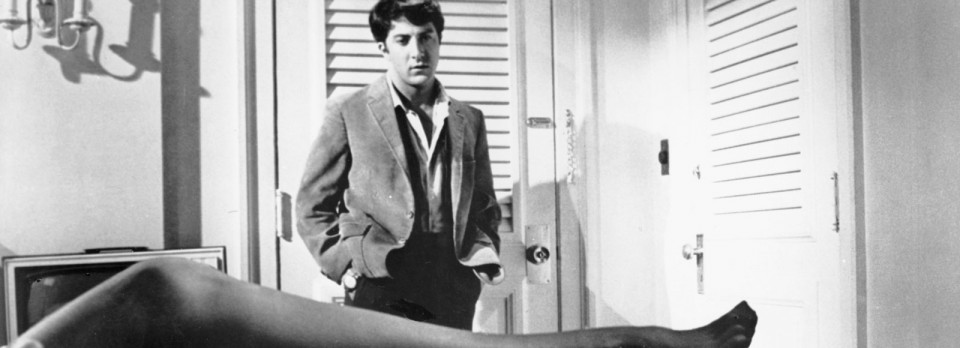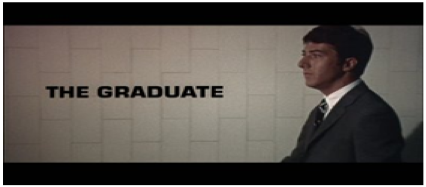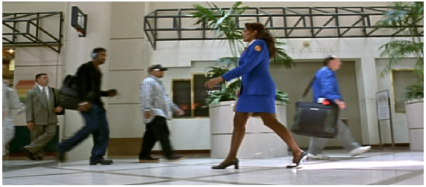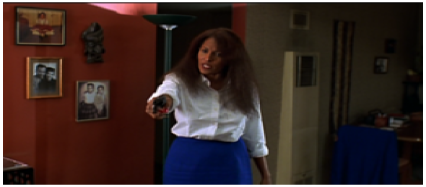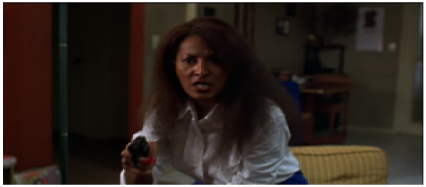Nowhere is the cinematic devaluation of African Americans more evident than in images of black women. Constructed through pervasive stereotyping and on the periphery of a white ideal of female beauty, black women in cinema have been cast as the racial Other. This Otherness has been constructed through many guises in the history of American cinema, including the desexualised “mammy” and the tragic “mulatto”. Some more recently recognisable identities include the bad single mother, the oversexed jezebel, the angry sapphire and the diva. Film scholars and feminists alike have lamented this historical lineage of stereotyping and the negativity that seems to cling to representations of black women in U.S. cinema, yet there is still much to be said about black women as presented within interracial relationships. This essay argues that Jackie Brown draws attention to and amplifys the racial difference of African American protagonists, Jackie Brown. This argument is evidenced through an instance of racial displacement and an exhibition of Pam Grier’s cultural verisimilitude as the “queen of Blaxploitation”.
While the Self, the Other and Otherness may seem familiar or universal concepts, it is important to acknowledge their abundance in twentieth century discourses such as psychoanalysis, philosophy, colonialism and post-colonialism. Although many theorists have given their definitions of these terms, I employ Sander L. Gilman’s comments here as they neatly summarise the selective mechanisms at work in constructing the Other:
In ‘seeing’ (constructing a representational system for) the Other, we search for anatomical signs of difference such as physiognomy and skin color. The Other’s physical features, from skin color to sexual structures […] are always the antithesis of the idealised self’s (qtd. in Young 31).
Two points arise here. First, by defining the Other, there is an implicit acknowledgement of the opposite i.e. the Self. Second, constructions of the Other operate, and arguably depend upon, strict, identifiable physical registers of difference. In Homi K. Bhabha’s Fanonesque essay, “The Other”, she distinguishes the concept of the racial Other as “at once an object of desire and derision, an articulation of difference contained within the fantasy of origin and identity” (19). As the analysis below reveals, this paradox manifests as fantastical and desirable in Jackie Brown.
An examination of Jackie Brown calls for an acknowledgment that the film is an adaptation of Elmore Leonard’s novel Rum Punch (1992). Tarantino’s “fantasy casting” of African American Grier is not in keeping with the original text since the female protagonist in the novel, Jackie Bourke, is racially “unmarked, which is to say she is white, not black” (Bauer 7; Miklitsch, 299). While racial allocation is perhaps less important in novelistic characterisation, film is inherently visual. Therefore, casting black actress Grier inevitably has a simple visual impact. However, ultimately this casting choice informs many stylistic qualities in the film. As a result, Jackie Brown’s African American identity is stressed and centralised.The opening sequence will be analysed here to demonstrate this. As Figures 3.1 and 3.2 illustrate below, Tarantino pays homage to Benjamin Braddock’s (Dustin Hoffman) introduction in The Graduate (d. Mike Nichols, 1967) through the similar use of a continuous medium profile shot, capturing Jackie, just like Benjamin, on an airport moving walkway. While this opening shot exemplifies Tarantino’s playful and highly-referential filmmaking style, as well as marking the film as a character piece and notably different in pace to the frenzied violence in Reservoir Dogs (1992) and Pulp Fiction (1994), it nevertheless positions Jackie’s race, and in this case her gender also, as different – different from the original, white male as seen in The Graduate.
Grier/Jackie’s racial difference informs Tarantino’s decision to bookend the film with Bobby Womack’s “Across 110th Street” (1971). This reading is supported by Tarantino’s comments which provide particular insight into the importance of song choice: “I’m always trying to find the right opening credit or closing credit sequence music early on […] Once I find it, that really triggers me into the personality […] of what the piece should be” (Barnes and Heam 109). The “personality” of the film, then, is indebted to the cultural verisimilitude Grier retains onscreen as an icon (however regressive) of black femininity in the 1970s in films like Foxy Brown (d. Jack Hill, 1974) and Coffy (d. Jack Hill, 1973). Tarantino’s choice of this song, (originally written by Womack for Across 110th Street (d. Barry Frears, 1972)), further cements the Blaxploitation connection. This song, like the one in The Graduate, provides a vehicle for expressing the thoughts and feelings of the central protagonist. Just as the lyrics of Simon and Garfunkel’s “The Sound of Silence” (1964) denote Benjamin’s feelings of disillusionment and isolation, the lyrics of Womack’s “Across 110th Street”, in the opening stanza below, foreshadow Jackie’s desperate situation– a situation fraught with financial struggles and moral dilemmas (qtd. in Miklitch 291):
I was the third brother of five
Doing whatever I had to do to survive
I’m not saying what I did was alright
Trying to break out of the ghetto was a day to day fight
With racial epithets such as “brother” and “ghetto”, the lyrics inevitably introduce and contextualise Jackie pointedly within an African American culture and experience (qtd. in Miklitch 291). This type of contextualisation is also evident in the use of “Long Time Woman”, recorded by Grier for prison film The Big Doll House (d. Jack Hill, 1971). The song skilfully accompanies Jackie’s short stint in jail, shown through montage in a way that stresses her experiences as a black woman in jail. Referring to Womack’s song, Miklitch points out: “the opening notes [of Womack’s song] precede the pre-title sequence”, the significance of this being that, given the song’s overall soulful rhythm, Jackie walks into an audiovisual space already predetermined and coded as African American (291). That is not to suggest this predetermination is negative; if anything the song bestows on Jackie a sophistication, or “coolness” – “coolness” being a recurrent character attribute in Tarantino’s body of work. Negativity and “coolness” aside, this predetermination ultimately categorises Jackie’s racial identity as fixed within the binary confines of race.
A final note should be made about the duration of the opening shot. Lasting the entire credit sequence, it invites a “closer look” at the small, visual details of Jackie’s appearance. Stella Bruzzi comments in a review of the film:
Because nothing much else is going on here, we are lured into becoming obsessively attentive to details, such as Jackie’s garish company badge, the cheap blue of her jacket contrasting with the rich browns of her hair and skin, the elegant curve in her nose and her ambiguous eyes, both vulnerable and self-contained (39).
As Bruzzi argues, Jackie’s blue airline uniform – and I would also add – the dark purple tiling of the back wall and the yellow credit titles (Figure 3.1) – contrast with Jackie’s physical features, or what Gilman referred to in his description of the selective process of constructing the Other as “anatomical signs of difference” (qtd. in Young 31). These colour contrasts draw attention to the very fact Jackie is black. Taken together, the continuous static medium profile shot, the use of non-diegetic music, the duration of the shot and the colour contrasting combine as cinematic syntax that, however well-intentioned, emphasise Jackie’s race as different, as Other. Awareness of Jackie as the racial Other is exacerbated by the reference to The Graduate. I disagree with Jim Smith’s assessment of Tarantino’s intertextuality as “spurious”; instead, I would argue in this instance, it is a deliberate and skilful positioning of Jackie’s race and gender as second to the original white male, Braddock (6). Yet, in identifying Tarantino’s cinematic syntax and intertextual reference here, I am not suggesting it offers a negative visualisation of African American femininity – on the contrary, the contemporary U.S. film industry rarely produces black women character films with the same sincerity and admiration as Tarantino does for Grier here. Even so, it is striking Tarantino makes these connections continually throughout the film.
The remaining analysis of Jackie Brown proceeds in two stages: a cinematographic analysis evidencing Tarantino’s admiration for Grier and a further scene exposing Tarantino’s way of cementing the connection to her earlier career and persona in the Blaxploitation era. Just after the credit sequence, Jackie is seen walking through the airport. As Figure 3.3 below illustrates, Tarantino affords a slight low angle in this shot. In accentuating Grier/Jackie’s figure, he values this type of femininity, as tall, womanly and African American. Given the “‘feminine’ cultural hierarchy” where the “standards of beauty are shaped by the dominant [white] group”, then, this shot, as does the rest of the film, stands as noticeably progressive against the racial and cultural meanings associated with femininity, beauty and desirability (Manatu 90). Moreover, the slight angle marks Tarantino’s personal recognition of Grier’s iconic status; the slight angle elevates Grier as the “queen of Blaxploitation” (Guerrero 1993, 93). Fred Botting and Scott Wilson neatly summarise this scene as:
True romance, the love affair of lens and image […] The director’s enamouration with this rediscovered icon of the seventies is translated into the unflinching absorption of cinematic homage, a fantasy as full as the figure who fills the screen (165).
The subtle low angle in this shot clearly demonstrates Tarantino’s personal fascination with Grier endorsing the comments above. Tarantino’s frequent showcasing of Grier’s cultural verisimilitude is highlighted when Ordell (Samuel L. Jackson) visits Jackie the night she is released from jail. This scene is loaded with obvious racial signifiers which exploit this cultural verisimilitude. The unashamed use of racial epithets in Tarantino’s rhythmic, ironic dialogue evidences this. The dialogue takes a central role as the lights are switched off for most of the scene and Jackie is heard shouting to Ordell in the darkness: “Get your hands off from my neck, nigger” and, “I’m gonna unload both of these motherfuckers if you don’t do what I tell you to do, do you understand what I am sayin’?” Both the type of language and Grier’s delivery of these lines with a slow, deep timbre in her voice points to the same strength as seen in Foxy Brown where she is described in the trailer as the “baddest One-Chick-Squad that ever hit town!”
As the scene progresses, the lights turn back on and Jackie takes control as she points the gun at Ordell. Jackie’s street-wise attitude and strong demeanour, (Figures 3.4 and 3.5), undoubtedly harks back to Grier’s persona in the Blaxploitation era. Tarantino even goes as far to say that Jackie is “Coffy, 20 years later, is Foxy Brown 20 years later”, a comment which signals he was knowingly presenting Jackie in this way (qtd. in Miklitsch 304). For all the aesthetic sophistication and nuances of Jackie Brown, Tarantino explicitly draws attention to Grier’s physicality, right from the opening sequence, and capitalises on her cultural verisimilitude which ultimately casts Jackie Brown as the racial Other. In so doing, the characterisation of Jackie is built on obvious racial signifiers, as apparent in the film’s auditory canvas, aforementioned street-wise attitude and dialogue with Ordell.
Bibliography
Barnes, Alan & Heam, Marcus. Tarantino, A to Zed: The Films of Quentin Tarantino. London: Batsford, 1996. Print.
Bauer, Erik. “The Mouth and the Method”, Sight and Sound, 3,1. (March 1998): 7-9. Print.
Botting, Fred & Wilson, Scott. The Tarantinian Ethics. London: Sage Publications Ltd., 2001. Print.
Bruzzi, Stella. “Review: Jackie Brown”, Sight and Sound, 8.4. (April 1998): 39-40. Print.
Guerrero, Ed. Framing Blackness. Temple University Press: Philadelphia, 1993. Print.
Miklitsch, Robert. “Audiophilia: audiovisual pleasure/narrative cinema in Jackie Brown”, Screen 45, 4. (Winter 2004): 288 – 304. Print.
Smith, Jim. Tarantino. London: Virgin Books, 2005. Print.
Young, Lola. Fear of the dark: ‘race’, gender and sexuality in the cinema. London: Routledge, 1996. Print.
